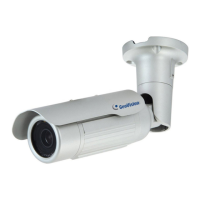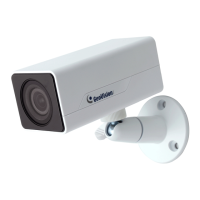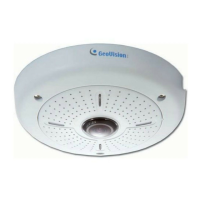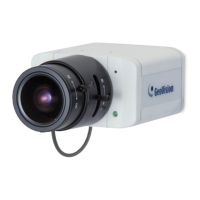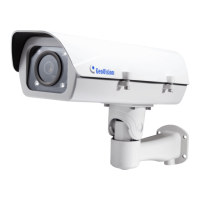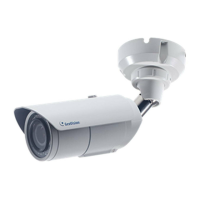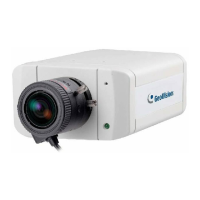
Do you have a question about the GeoVision GV-EFD2100 Series and is the answer not in the manual?
| Lens Type | Fixed |
|---|---|
| Video Compression | H.264, MJPEG |
| IR LED | Yes |
| WDR | Yes |
| Video Resolution | 640 x 480 |
| Aperture | F2.0 |
| Gain Control | Automatic |
| Audio Compression | G.711 |
| Audio Input | Yes |
| Ethernet | 10/100 Ethernet |
| Protocol | TCP, UDP, HTTP, HTTPS, SMTP, FTP, DHCP, NTP, DDNS, RTP, RTSP, PPPoE, UPnP |
| Operating Temperature | -10 °C ~ 50 °C (14 °F ~ 122 °F) |
| Power Source | PoE |
| Sensor | 1/2.8" Progressive Scan CMOS |
| Minimum Illumination | 0.05 Lux (Color) |
| Network Interface | 10/100 Ethernet |
| White Balance | Automatic |
Details PC and browser requirements for operating the GV-IPCAM H.264 via a web browser.
Lists all the items included in the Box Camera package.
Details the key features of the Box Camera series, including image sensor, dual streams, and connectivity.
Explains the Wide Dynamic Range Pro feature and its benefits for contrasting light scenes.
Provides a physical overview of specific Box Camera models with labeled components.
Explains the process of connecting Box Cameras, including network and power connections.
Describes optional accessories for Box Cameras like C-Mount lenses and IR illuminators.
Details the I/O terminal block for one input and one output device and its pin assignment.
Lists all items included with the Ultra Box Camera package.
Details the features of Ultra Box Cameras, such as image sensor, dual streams, and frame rates.
Provides a physical overview of the Ultra Box Camera, showing labeled components and LEDs.
Guides through the installation process for Ultra Box Cameras on walls and ceilings.
Explains how to connect power and network cables to Ultra Box Cameras.
Lists all items included in the Target Box Camera package.
Describes the features of Target Box Cameras, including image sensor and frame rates.
Provides a physical overview of the Target Box Camera, showing labeled components and LEDs.
Guides through the installation process for Target Box Cameras on walls and ceilings.
Explains how to connect power and network cables to Target Box Cameras.
Lists all items included with the IR Arctic Box Camera package.
Details features of IR Arctic Box Cameras, including image sensor, dual streams, and frame rates.
Provides a physical overview of the IR Arctic Box Camera, showing labeled components.
Guides through the installation process for IR Arctic Box Cameras for outdoor use.
Explains how to connect power and network cables to IR Arctic Box Cameras, including wire definitions.
Provides important notices regarding IR LED functionality and status LED behavior.
Lists all items included in the Bullet Camera package.
Describes the features of Bullet Cameras, including image sensor, dual streams, frame rates, and IR distance.
Provides a physical overview of the Bullet Camera, showing labeled components.
Guides through the basic installation of Bullet Cameras.
Defines the wire colors and their functions for connecting the Bullet Camera.
Explains how to adjust the camera body and base angles in three shafts for installation.
Details how to adjust the camera's lens for clarity and insert a micro SD card.
Lists all items included in the Ultra Bullet Camera package.
Details the features of Ultra Bullet Cameras, including image sensor and frame rates.
Provides a physical overview of the Ultra Bullet Camera, showing labeled components.
Guides through the installation process for Ultra Bullet Cameras on ceilings or walls.
Explains how to waterproof the LAN/PoE cable using the supplied cable connector.
Lists all items included in the Target Bullet Camera package.
Describes the features of Target Bullet Cameras, including image sensor and frame rates.
Provides a physical overview of the Target Bullet Camera, showing labeled components.
Guides through the installation process for Target Bullet Cameras on ceilings or walls.
Defines wire colors and their meanings for connecting the Target Bullet Camera.
Lists all items included in the PTZ Camera package.
Details the features of PTZ Cameras, including image sensor, dual streams, and zoom capabilities.
Provides a physical overview of the PTZ Camera, showing labeled components and LEDs.
Guides through the ceiling and wall mount installation procedures for PTZ Cameras.
Explains how to connect network cables, power, speakers, and other devices to the PTZ Camera.
Guides on adjusting the focus for image clarity using the PTZ control panel or web interface.
Details the pin assignment for the 3-pin terminal block for digital input and output.
Explains how to control PTZ functions like focus, image quality, and camera movements via the web interface.
Lists all items included in the PT Camera package.
Details the features of PT Cameras, including image sensor, dual streams, and pan/tilt capabilities.
Provides a physical overview of the PT Camera, showing labeled components and LEDs.
Refers to Chapter 12 for installation procedures.
Refers to Chapter 12 for connection procedures.
Guides on adjusting image clarity using the GV-IP Device Utility.
Details the pin assignment for the 3-pin terminal block for digital input and output.
Describes the supported functions and controls for PT Cameras, referencing PTZ controls.
Lists all items included in the Vandal Proof IP Dome package.
Describes features of Vandal Proof IP Domes, including image sensor, WDR Pro, and low lux capabilities.
Provides a physical overview of Vandal Proof IP Domes, showing labeled components.
Guides through hard-ceiling and in-ceiling mount installation for Vandal Proof IP Domes.
Explains wire definitions, power connection, and voltage load expansion for Vandal Proof IP Domes.
Lists all items included in the Vandal Proof IP Dome (Part II) package.
Describes features of Vandal Proof IP Domes (Part II), including sensor, illumination, and resistance standards.
Provides a physical overview of Vandal Proof IP Domes (Part II), showing labeled components.
Guides through the installation process for Vandal Proof IP Domes, emphasizing wire threading and conduit connectors.
Explains power connection and I/O device connections for Vandal Proof IP Domes.
Lists items for Hard-Ceiling Mount and In-Ceiling Mount for Fixed IP Domes.
Details features of Fixed IP Dome cameras, including image sensor, dual streams, and frame rates.
Provides a physical overview of the Fixed IP Dome, showing labeled components.
Guides through hard-ceiling, in-ceiling, and wall-surface mount installations for Fixed IP Domes.
Explains how to connect network, power, and other cables to the Fixed IP Dome.
Details the I/O terminal block for one input and one output device and its pin assignment.
Lists all items included in the Cube Camera package.
Details features of Cube Cameras, including image sensor, dual streams, and frame rates.
Provides a physical overview of the Cube Camera, showing labeled components.
Guides through the installation process for Cube Cameras.
Explains how to connect network and power cables to Cube Cameras.
Lists all items included in the Advanced Cube Camera package.
Details features of Advanced Cube Cameras, including image sensor, dual streams, and PIR sensor.
Provides a physical overview of the Advanced Cube Camera, showing labeled components.
Guides through the installation process for Advanced Cube Cameras.
Explains how to connect network and power cables to Advanced Cube Cameras.
Guides on accessing the live view by checking IP address, configuring IP, and setting up wireless connection.
Guides on adjusting image clarity using GV-IP Device Utility and focus adjustment cap.
Outlines important features that can be configured after installation, such as date/time, passwords, and network settings.
Provides steps to access surveillance images via web browser, including login and password.
Introduces features of the Live View window and Network Status accessible in Guest Mode.
Describes the Live View window interface when accessed using Internet Explorer.
Explains the functions accessible via the control panel of the Live View window.
Covers video image settings and management through Motion Detection, Privacy Mask, Text Overlay, Tampering Alarm, and Visual Automation.
Details settings for video compression, stream, frame rate, and image settings.
Explains how to configure motion detection areas and sensitivity for alarm generation.
Describes the Privacy Mask function to block sensitive areas on live view and recorded clips.
Details how to enable recording function, including memory card insertion and setting recording schedules.
Explains methods for playing back video files recorded on the GV-IPCAM H.264.
Guides on playing back files by connecting the memory card via a card reader and using Ext2Fsd program.
Explains how to play back files using the Remote ViewLog function over a TCP/IP network.
Details how to download and install updated firmware via web interface or IP Device Utility.
Explains how to back up and restore camera configurations using the IP Device Utility.
Guides on restoring camera settings to factory defaults for various camera types.
Explains how to change login passwords for Administrator and Guest accounts.
Guides on setting up GV-IPCAM H.264 on GV-System, including adding and scanning cameras.
Describes how to use Multi View to monitor and manage GV-IPCAM H.264.
Explains how to use Remote E-Map for monitoring and managing GV-IPCAM H.264.
Explains how Center V2 monitors and manages cameras and I/O devices connected to GV-IPCAM H.264.
Describes VSM for monitoring and managing cameras and I/O devices connected to GV-IPCAM H.264.
Explains how the Dispatch Server minimizes overloading of Center V2 Servers.
Provides settings for Internet Explorer 8 to ensure proper functionality.
Lists supported lenses for Box Camera from different providers.
Details the frame rate and performance variations based on connections and data bitrates.
Lists supported versions for GV-Backup Center, GV-Video Gateway, and GV-Recording Server.
